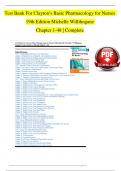Exam (elaborations)
TEST BANK For Clayton’s Basic Pharmacology for Nurses 19th Edition By Michelle Willihnganz | Complete Chapter's 1 - 48 | 100 % Verified
- Course
- Institution
- Book
TEST BANK For Clayton’s Basic Pharmacology for Nurses 19th Edition By Michelle Willihnganz | Complete Chapter's 1 - 48 | 100 % Verified
[Show more]



